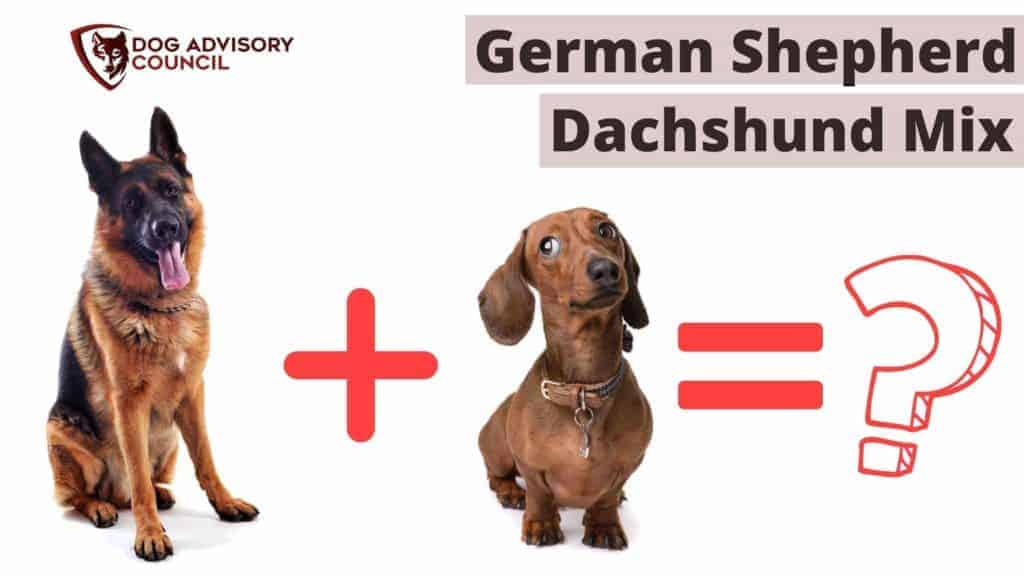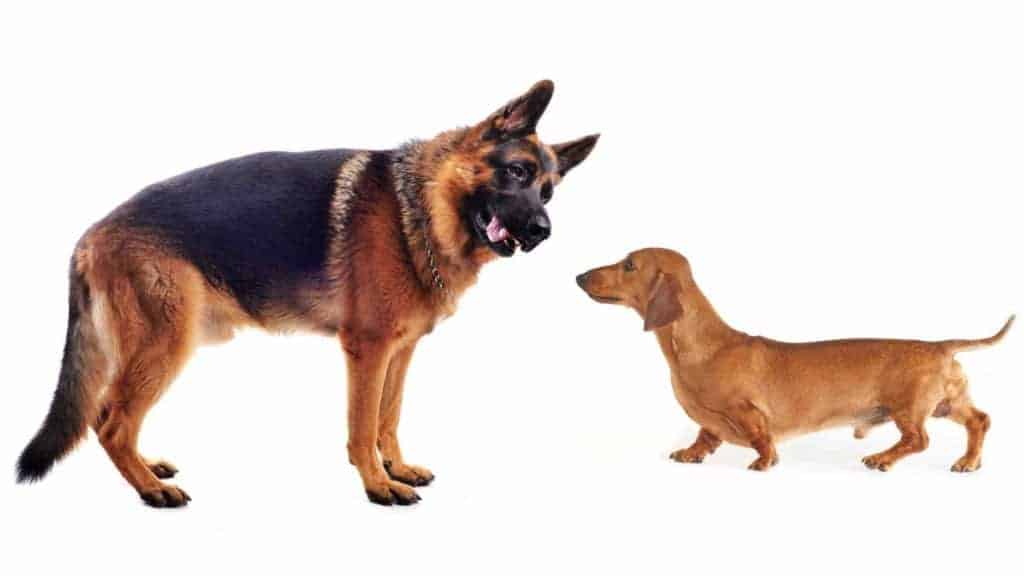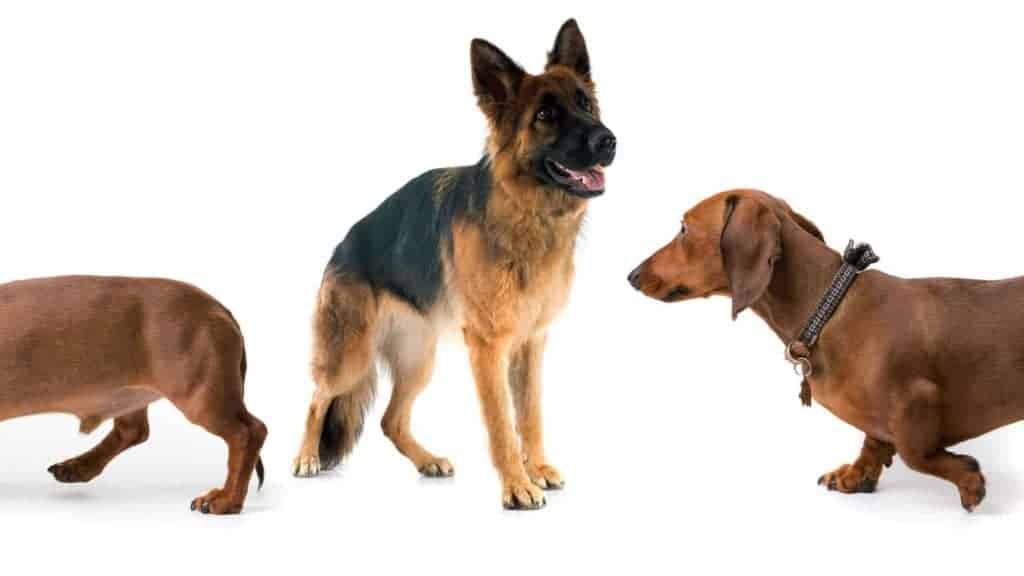
Both German by origin, a German Shepherd Dachshund mix makes for a truly interesting combination when looking for a dog to add to your family. Here’s what you are going to want to know about it.
A Dachshund Shepherd will be between 10-20 inches (25-50 cm) and weigh between 20-60 pounds (9-27 kg). This will vary depending on which dog has stronger genes since both parent dogs have a drastic size difference!
These are friendly, loyal, and intelligent dogs that do well in families, though they will need proper socialization, especially young children and other pets.
What do you call a Dachshund and German Shepherd mix?
Amongst dog breeder circles, the formal name for a German Shepherd Dachshund mix is Dachshund Shepherd. While some designer breeds will have a few name variations, this one just has one name.
Can a German Shepherd mate with a Dachshund?
A common question, of course, when you think about the logistics of breeding these two dogs together! The German Shepherd is the mama-to-be since it will be safer for her to carry the puppies. So, that leads to the inevitable question: how is mating possible?
The answer: artificial insemination, of course! This is common with many “illogical” designer breeds and is considered standard practice for dog breeders specializing in them. It also helps reduce stress on both dogs, which helps ensure a better chance of pregnancy.
As far as the success rate in the pregnancy, it depends on the health of both dogs and the insemination process itself. This is a huge part of why going with an experienced breeder is so important.
What does a German Shepherd Dachshund mix look like?
These Dachshund Shepherd puppies tend to be a lovely combination of both breeds, which makes for an exceptional blend of both types of dogs as far as looks are concerned.
From their Dachshund parent, they often will inherit the shorter legs and turned out parent (though not every time). They can have varying fur colors depending on the kind of Dachshund parent they have (see the list of colors below) in their lineage. Blended between German Shepherd and Dachshund, the most common colors are:
- Dark brown
- Black
- Blue
- Brindle
- Merle
- Red
Most will have the mask of a German Shepherd on their face. It might be a complete mask, a partial mask, or splotched. This is where you can see just how the dominant genes are coming out!
Their ears can be either droopy or stand-up, depending. They often appear enormous compared to the rest of their heads, which is part of their adorable charm! In some cases, the ears will be one of each for even more fun.
There are four different color variations that your dog can have, depending on which genes decide to be more prominent in that particular trait for your dog. These include:
- Smooth
- Wirehaired
- Medium haired
- Longhaired
As you can probably guess, the longer the hair, the stronger the German Shepherd genes, and vice versa!
How big do German Shepherd Dachshund mixes get?
Most will define these as being medium-sized dogs. They will be shorter than a purebred German Shepherd and taller than a Dachshund. However, it depends on whether your breeder uses a standard-sized Dachshund or a miniature (in which case, these numbers won’t apply).
In classic cases, these dogs will be 10-20 inches (25-50 cm) in height and weigh between 20-60 pounds (9-27 kg). The more German Shepherd that comes out in the puppy, the more weight will rise.
Weight, as you’ll learn below, is going to be one of the main factors for caring for your dog properly, so you’ll want to get a perfect estimate on that.
Your breeder can give you great source information on the parents, and your vet will help make sure that you are hitting all of the proper milestones at just the right times.
The lifespan of a German Shepherd Dachshund mix
The lifespan for this mixed breed varies widely between 7-14 years. This is mostly because the Dachshund can be prone to serious long-term health problems (more on that below), so they can have shorter lifespans as a result.
Of course, proper attention to health, potential health conditions, and a great relationship with your vet will help. As well, some of these can be minimized with proper breeding and screening. Yet another reason to carefully source your breeder!

The temperament of a German Shepherd Dachshund mix
Both breeds have strong personalities, all things considered. If you’re curious about how that will come out in this mixed dog breed, you’ll be pleasantly surprised!
Both breeds are loyal, so you’ll be graced with a dog that will be very loyal and protective. They make great companion dogs for those that want those traits as priorities!
One word of caution here, though, is that they can be overprotective. While they will be protective of their whole family, they will be partial to their master. This means that they will try to defend their master from those around them…including family members!
These are also sociable dogs that enjoy being out and seeing new people. One of the coolest features is that they will appear aloof with guests and strangers, but they are actually carefully watching them to ensure they mean no harm. How cute is that?
Since both parent breeds are energetic, you can expect these to be energetic as well. Most will need 90 minutes a day of exercise simply because they just have to keep moving. Think zoomies, but longer.
You’ll also need to focus on things like mental training since these are especially smart dogs that will require mental exercise as much as physical exercise.
Are German Shepherds Dachshund mixes good family dogs?
The reviews on this tend to be mixed. Generally, they are good family dogs. Since they are protective and will even put their own lives at risk to defend one of their own, these are reassuring furry companions to have in your household! They also enjoy being around kids and can be great playmates for each other.
However, they can sometimes be nippy or over-protective, which can sometimes mean fingers or toes get bitten. Since they will protect their master, this is something to think about when you have young children who don’t necessarily understand that they have to watch for signs of this in their dog. We’ll go into socialization training for your Dachshund Shepherd a bit more later on.
Their intelligence also makes them very trainable, which is going to be really effective when you are hoping to make this a family activity!
They’ll love classic obedience raining and will thrive in advanced tricks and other training where they can really learn, adapt, behave, and generally be active mentally and physically (like an obstacle course).
Most common Dachshund Shepherd health issues
As introduced above, there are quite a few health issues that you’ll want to be aware of when it comes to your mixed breed puppy.
Some of these can be screened for by responsible and professional breeders, but some are more “luck of the draw,” which often aren’t covered. Top ones to watch for include:
- Dysplasia
- Luxating patella
- Intervertebral Disc Disease
- Cataracts
- Mitral Valve Disease
Dysplasia
This is a big dog problem where the joint and the bone of the hips and elbow won’t work in sync with each other. This means that there will be friction and pain when moving those joints.
Often this gets worse with age, as it will correlate with problems like arthritis. It can be managed with medication if needed.
Luxating patella
This comes mainly from the Dachshund genes, and it is when the knee cap doesn’t line up with the leg’s bone correctly, temporarily dislocating it. It can be rare or frequent, depending.
This is often managed on its own, but it can be painful for your dog, and it can mean their stride or range of movement isn’t as normal as it would be in other dogs.
Intervertebral Disc Disease
This can come from both breeds, meaning that your pup can have a stronger likelihood depending on the breeding.
This is when the discs in the spine compress and cause pain and difficulty moving. It can even lead to paralysis in cases where it is untreated or severe.
Breeders can often catch markers of this, especially if they notice that their parents have it, but not always.
Cataracts
Common in most senior dogs, this condition is when the film on the eye becomes discolored and impacts vision.
While there are drops for treatment, this is only a short-term solution. Without surgery to remove that film, the dog will end up with partial or even complete blindness, depending.
Mitral Valve Disease
This is a serious condition where the blood doesn’t pump correctly from the heart. It is detected with proper gene monitoring, so most will want to check with your breeder about the policy on this and the screening they have in place.
How to take care of a Dachshund Shepherd
Taking proper care of your dog is going to be a little bit of everything, as you’d expect. In the case of this mixed-breed dog, you are going to focus on the following features for their long-term health:
- Weight management
- Portioning and diet
- Ear and teeth cleaning
- Mental stimulation
Weight management
When you are looking at their health, one of the most important things is their weight. Even if they don’t take on the overall shape of the Dachshund, they will have the same spinal weaknesses in their DNA.
To protect their spine and overworked joints, you’ll need to keep their weight in a healthy range.
Work with your doctor on portioning, and remember that one of the most important details for your dog’s health is going to be exercise. Since they love to move, this shouldn’t be too hard. But you’ll always need to keep an eye on their weight so that you can minimize the strain on their spine.
Portioning and diet
Dachshunds are particularly bad for chowing down, well, everything. If you give them 6 cups of food a day, they’ll eat it all without even hesitating.
As the responsible pet parent you are, you’ll need to prioritize their portion size and always stay within it. If you need to space it out into smaller meals throughout the day, go for it.
Don’t forget treats! Many don’t even realize that they overfeed on treats. Shop for healthy ones and be careful how many you give.
As far as the food itself, your vet can help you find a great choice. Generally, fiber and omega-3 are good since it delivers extra strength to their bones and joints for easier maintenance.
Ear and teeth cleaning
Cleaning both at the same time is a great habit to get into! Once or twice a week, you’ll need to wipe out their ears and brush their teeth with dog-approved products.
This will help ward off tooth decay, which can be a significant complication to managing a doggy diet. Since these dogs do have large ears, you’ll want to keep them clean and clear to prevent infection.
Mental stimulation
The natural intelligence of these dogs is going to be essential to satiate! This means puzzle mats, treat toys, and more. Anything that you can find to help keep their brain activity will help keep anxiety and destructive behavior to a minimum.
Your breeder and your vet can both give you great options to help keep them entertained, too, so don’t be afraid to ask!
How much is a German Shepherd Dachshund mix?
These dogs come with specialized breeding, so you can expect to pay anywhere between $400- $1 000. For the rarer colors and combinations of coat types, you’ll expect even to double those ranges!

Pros and cons of a German Shepherd Dachshund mix
Take a look at these summarizing pros and cons to help you get a feel for just what a Dachshund Shepherd is going to be able to offer the shopper looking for in a fun blend of dog breeds.
PROS
- Good blend of a lap dog and an active dog
- Medium-sized dog for comfort and general quality of life
- Extremely protective
While protectiveness can be a problem (more on that next), these dogs are great for families that will be accomodating that behavior. They like to be around humans and will be great playmates for kids and some pets.
Their size makes them excellent choices for those who don’t want a small dog but can’t have a large one easier.
Since they are so intelligent, they’ll be good choices for training, too. This is especially helpful if you want to look at the idea of specialized training with a dog who will enjoy it as much as you.
While they are active dogs, they will be great for cuddling up and enjoying some snuggle time, too, which is precisely what most will enjoy!
CONS
- Needs socialization training
- Shorter lifespan
- Needs as much mental stimulation as he does physical stimulation
- Can be loud
These dogs do need socialization training to ensure that they will be okay around kids and other animals.
Since they are known for being protective of their primary caregiver, this is a behavior that you will need to train them out of quickly to make sure that everyone’s safety is a priority.
Thanks to their health concerns, they often have a shorter lifespan than most would like. While this isn’t a reason to shy away from these kinds of dogs, it is something to consider if you are bringing one into a young family.
They are also very hyperactive mentally, so they’ll need proper stimulation for their brain as well as their body. Leaving them alone with nothing to do for hours at a time will likely destroy your home!
They also can be known for barking excessively, which will be challenging when you are looking at having a standard neighborhood or young children who are sleeping, etc. Again, these are just consideration factors to think about.
Dachshund Shepherds are sweet, friendly, and protective dogs with hearts of gold. Whether or not they are suitable for your family and their needs will be a matter of personal preference and attention to the correct details!
To summarise
This German-based cross-breed is a mix between a German Shepherd mom and a Dachshund dad.
They will measure between 10-20 inches (25-50 cm) and weigh between 20-60 pounds (9-27 kg) when they are full-grown adults, depending on the genes.
They are good with families but will need socialization training to help deter them from being overprotective in inappropriate situations.
They will have susceptibility to several health conditions, so proper detection and preventative care are essential!
